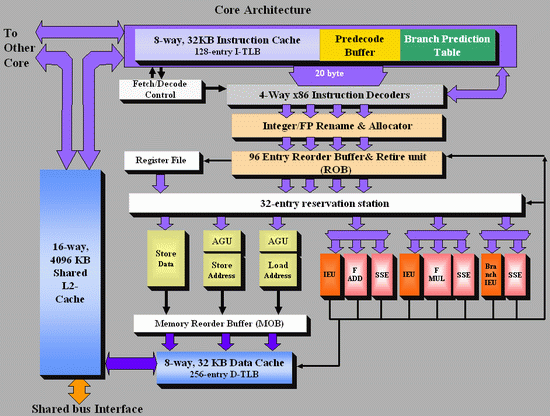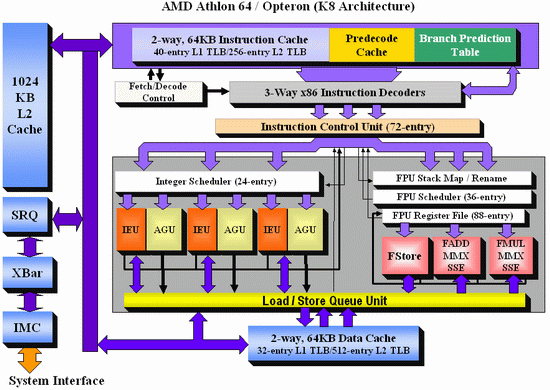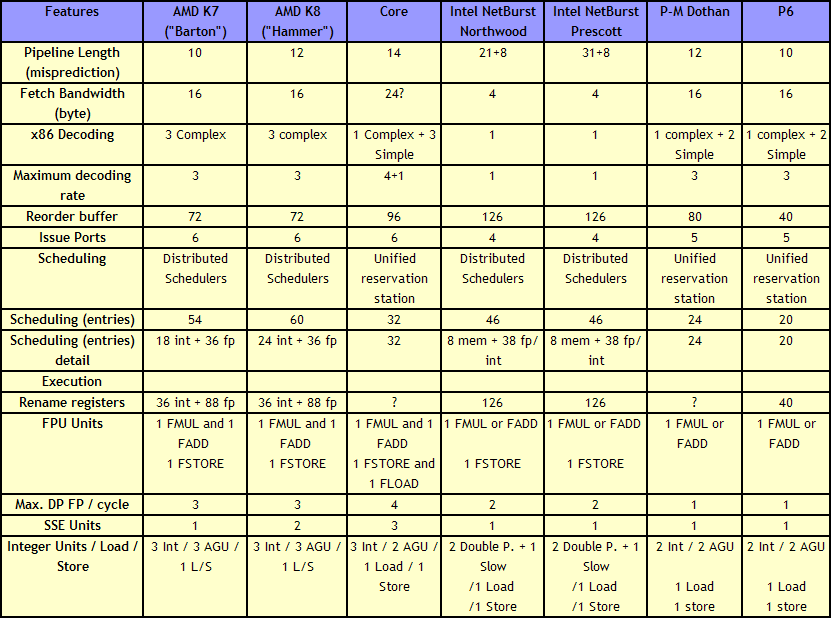Ten Year Anniversary of Core 2 Duo and Conroe: Moore’s Law is Dead, Long Live Moore’s Law
by Ian Cutress on July 27, 2016 10:30 AM EST- Posted in
- CPUs
- Intel
- Core 2 Duo
- Conroe
- ITRS
- Nostalgia
- Time To Upgrade
Core: Out of Order and Execution
After Prefetch, Cache and Decode comes Order and Execution. Without rehashing discussions of in-order vs. out-of-order architectures, typically a design with more execution ports and a larger out-of-order reorder buffer/cache can sustain a higher level of instructions per clock as long as the out-of-order buffer is smart, data can continuously be fed, and all the execution ports can be used each cycle. Whether having a super-sized core is actually beneficial to day-to-day operations in 2016 is an interesting point to discuss, during 2006 and the Core era it certainly provided significant benefits.
As Johan did back in the original piece, let’s start with semi-equivalent microarchitecture diagrams for Core vs. K8:
For anyone versed in x86 design, three differences immediately stand out when comparing the two. First is the reorder buffer, which for Intel ranks at 96 entries, compared to 72 for AMD. Second is the scheduler arrangement, where AMD uses split 24-entry INT and 36-entry FP schedulers from the ‘Instruction Control Unit’ whereas Intel has a 32-entry combined ‘reservation station’. Third is the number of SSE ports: Intel has three compared to two from AMD. Let’s go through these in order.
For the reorder buffers, with the right arrangement, bigger is usually better. Make it too big and it uses too much silicon and power however, so there is a fine line to balance between them. Also, the bigger the buffer it is, the less of an impact it has. The goal of the buffer is to push decoded instructions that are ready to work to the front of the queue, and make sure other instructions which are order dependent stay in their required order. By executing independent operations when they are ready, and allowing prefetch to gather data for instructions still waiting in the buffer, this allows latency and bandwidth issues to be hidden. (Large buffers are also key to simultaneous multithreading, which we’ll discuss in a bit as it is not here in Core 2 Duo.) However, when the buffer has the peak number of instructions being sent to the ports every cycle already, having a larger buffer has diminishing returns (the design has to keep adding ports instead, depending on power/silicon budget).
For the scheduler arrangements, using split or unified schedulers for FP and INT has both upsides and downsides. For split schedulers, the main benefit is entry count - in this case AMD can total 60 (24-INT + 36-FP) compared to Intel’s 32. However, a combined scheduler allows for better utilization, as ports are not shared between the split schedulers.
The SSE difference between the two architectures is exacerbated by what we’ve already discussed – macro-op fusion. The Intel Core microarchitecture has 3 SSE units compared to two, but also it allows certain SSE packed instructions to execute within one instruction, due to fusion, rather than two. Two of the Intel’s units are symmetric, with all three sporting 128-bit execution rather than 64-bit on K8. This means that K8 requires two 64-bit instructions whereas Intel can absorb a 128-bit instruction in one go. This means Core can outperform K8 on 128-bit SSE on many different levels, and for 64-bit FP SSE, Core can do 4 DP per cycle, whereas Athlon 64 can do 3.
One other metric not on the diagram comes from branch prediction. Core can sustain one branch prediction per cycle, compared to one per two cycles on previous Intel microarchitectures. This was Intel matching AMD in this case, who already supported one per cycle.













158 Comments
View All Comments
Namisecond - Thursday, July 28, 2016 - link
NVMe may not be all it's cracked up to be. It, for the most part, limits you to booting windows 8 and higher, and good luck with the free upgrade to windows 10 (which supposedly ends tomorrow).FourEyedGeek - Monday, August 8, 2016 - link
Same CPU here, mine is running at 4Ghz, I can't see a reason other than NVMe to upgrade.dotwayne - Thursday, July 28, 2016 - link
Had a trusty E6300 @ 3.4-5 ghz back then. ahhh...miss those days of oc-ing the shit out of these cheap but super capable silicons.jamyryals - Thursday, July 28, 2016 - link
Neat article, I enjoyed it Ian!azazel1024 - Thursday, July 28, 2016 - link
Yeah a lot of those assumptions and guestimates for the future seem either overly optimistic or seem to ignore realities. I realize board power doesn't equate to average power use, but you are still talking about max power consumption that would drain a current cell phone battery dead in less than an hour, even on some of the biggest phone batteries.Beyond that is the heat dissipation, that phone is going to get mighty hot trying to dissipate 8+ watts out of even a large phone chassis.
As pointed out, 32 cores seems a wee excessive. A lot of it seems to be "if we take it to the logical extreme" as opposed to "what we think is likely".
Peichen - Thursday, July 28, 2016 - link
Take a 45nm C2Q Q9650 ($50 eBay), overclock to 4.0GHz, and you will be as fast as AMD's FX-9590 that's running at 220W. Older motherboard and DDR2 will be harder to come by but it is sad how AMD never managed to catch up to Core 2 after all these years. E6400 was my first Intel after switching to AMD after the original Pentium and I have never look back at AMD again.Panoramix0903 - Thursday, July 28, 2016 - link
I have made an upgrade from C2D 6550 to Q9650 in my old DELL Optiplex 755 MT. Plus 4x 2GB DDR2 800 MHz, Intel 535 SSD 240 GB, Sapphire Radeon HD7750 1GB DDR5, Sound Blaster X-FI, and USB 3.0 PCI-E card. Running Windows 7 Professional. 3-times more power then original DELL configuration :-)JohnRO - Thursday, July 28, 2016 - link
I just logged in to tell you that I'm reading this article on my desktop PC which has a Intel Core 2 Duo E4300 processor (1,8 GHz, 200 MHz FSB) with 4 GB of RAM (started with 2). When I wanted (or needed) I overclocked this processor to 3 GHz (333 MHz FSB).My PC will have its 10 years anniversary this December. During the years I upgraded the video card (for 1080p h264 hardware decoding and games when I still played them) and added more hard drives. The PC has enough performance for what I’m using it right now – so I would say that this is a good processor.
siriq - Thursday, July 28, 2016 - link
I still got my mobile 2600+ barton @2750 mhz , 939 3800+ x2 @2950 mhz . They were awesome!althaz - Thursday, July 28, 2016 - link
I bought a C2D E6300 the week it came out, my first Intel CPU since 2000. My previous CPUs had been an AMD Athlon 64 and an AMD Athlon Thunderbird.That E6300 remains my all-time favourite CPU. It's still running in a friend of mine's PC (@ 2.77Ghz, which I overclocked it to soon after getting it). It was just *so* fast compared to my old PC. Everything just instantly got faster (and I hadn't even upgraded my GPU!).